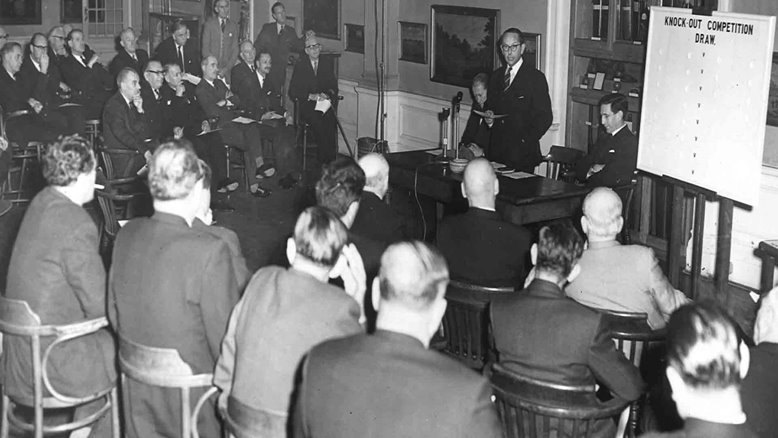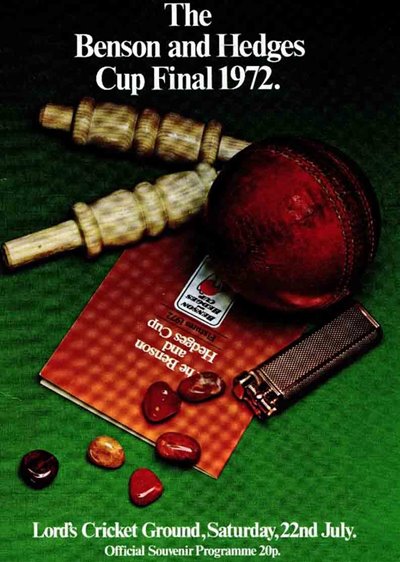As Lord’s looks forward to its last One-Day Cup final, and to coincide with the MCC Museum’s new display on cricket tournaments, MCC Archivist Rob CurphEy looks at the history of one-day finals at Lord’s.
The idea for creating a knock-out competition for counties had been first discussed by MCC just after the Second World War, and then again in the late 1950s, but it was in the early 1960s that an idea of a knock-out competition finally came to fruition.
MCC compiled a special sub-committee to discuss improvements to county cricket, known as the 1961 Cricket Enquiry, and one of the major recommendations, proposed by Gubby Allen, was to introduce a knock-out competition, in order to attract more spectators to the game.

Thus, with the agreement of the counties, MCC established a Knock-Out Competition Sub-Commit
ee to administer a knock-out cricket competition in time for the 1963 season, with the playing conditions based on a successful knock-out tournament held between the Midlands-based counties (Northamptonshire, Derbyshire, Leicestershire and Nottinghamshire) in 1962.
The minutes of the MCC Committee meeting held in October 1962 confirm that the final of a one-day competition would be held at Lord’s, and proposed that the matches would consist of one innings each of 65 overs, with matches taking place between 11am-7.30pm, while the teams drawn first would play at home, and MCC agreed to accept an offer of sponsorship for the competition from the Gillette Safety Razor Company Limited.
Other conditions included allowing bowlers a limitation of 15 overs, and ensuring that counties set aside three days to complete each match, and if games were not completed due to the weather, then a 10-over match would take place as soon as possible to confirm the result!
The draw was conducted by MCC, and the initial format of the competition was straight knock-out, akin to football’s FA Cup competition, where one loss meant you were eliminated from the tournament.
This posed a problem, as there were 17 first-class counties to fill 16 places. So it was decided that the two teams occupying the bottom places in the previous year’s County Championship would have to play-off for a place in the first round.
On 1 May 1963, the first Gillette Cup match was held when Lancashire played Leicestershire in a special preliminary match at Old Trafford, with the hosts winning by 101 runs.
Lancashire then went on to defeat Derbyshire by 5 wickets in the Quarter-Finals. The Quarter-Final stage also witnessed the first knock-out match held at Lord’s – with Northamptonshire defeating Middlesex by six wickets.
The final, held at Lord’s on September 7th, 1963, was between Sussex and Worcestershire. In a dramatic match, Sussex, under the captaincy of Ted Dexter, won by 14 runs, despite a man-of-the match performance from Worcestershire’s Norman Gifford, who took 4 wickets.
The competition was a success, and it was therefore agreed by members of the MCC Knock-Out Competition Sub-Committee to continue with the competition, and minor counties were also invited, bringing the number of participants in the 1964 edition to 22, however the winners remained the same; Sussex defeated Warwickshire by 8 wickets in the final at Lord’s on September 5th, 1964.
The MCC Museum’s current exhibition on tournaments has a display dedicated to the first one-day final, containing photographs, scorecards and advertisements from that first final.
The Gillette Cup was the only one-day final held at Lord’s until the early 1970s, when it was decided by the Test and County Cricket Board, who had succeeded MCC’s responsibility for domestic cricket, to make the start of the season more interesting.
Thus a new one-day tournament would be introduced with a mid-season final held at Lord’s in July, known as the Benson and Hedges Cup. Unlike the Gillette Cup which was by 1972 still a knockout format, the Benson and Hedges Cup consisted of four regional groups of county teams, and Cambridge University and two Minor Counties teams representing the North and South were also invited to participate to obtain an even number of groups.

The first final, held at Lord’s on July 22nd, 1972, was a special day for Ray Illingworth; he captained Leicestershire against a Yorkshire team he had served with distinction for 18 years. Illingworth later claimed that he was ‘more nervous in that match than any other in my life’ but he ended the day holding the trophy, as Leicestershire won by five wickets and J C Balderstone was named man of the match for contributing 41* as Leicestershire successfully chased down Yorkshire’s total of 136.
more nervous in that match than any other in my life - Ray Illingworth
The two finals were played at Lord’s every year from 1972-2002, when the Benson and Hedges Cup was disbanded – and ultimately replaced in the domestic calendar by the Twenty20 Cup.
By 2002, the Gillette Cup had changed its name to the Cheltenham and Gloucester Trophy, having been called the NatWest Trophy from 1981-2000. This summer, Lord’s will host its sixth Royal London One-Day Cup Final and 88th one-day final.
Lancashire are the most successful county team in one-day finals at Lord’s, with 11 victories (four Gillette Cup, three NatWest Trophy, four Benson and Hedges Cup). This included a hat-trick of Gillette Cup titles between 1970 and 1972, back-to-back Benson and Hedges Cup trophies in 1995 and 1996, the ‘double’ of winning the NatWest Trophy and Benson and Hedges Cup twice in 1990 and 1996 – a feat matched by Gloucestershire in 1999.
The best bowling figures for any one-day final were posted in the 1996 NatWest Trophy final by Lancashire’s Glen Chapple, who took 6 for 18 when helping his side defeat Essex by 129 runs.
Joel Garner and Jade Dernbach are the only other two bowlers to have taken 6 wickets in a Lord’s final, for Somerset (1979) and Surrey (2015) respectively.

The highest individual innings in a one-day final came only two years ago, when Alex Hales made a magnificent score of 187* to help Nottinghamshire defeat Surrey by four wickets.
After the game, Hales donated his matchworn shirt to the MCC Museum, where it is currently on display as part of our new ‘Tournaments’ exhibition looking at cricket competitions, alongside the shirt of Rilee Rossouw, who donated his shirt to MCC after making a century for Hampshire against Kent in 2018. Hopefully more special memories will be made in the ‘final’ one-day final…
Royal London One-Day Cup 2019